Taking a closer look at 1Camera studied from an insider and outsider POV to consider the stakes which lead to the needs of this research.
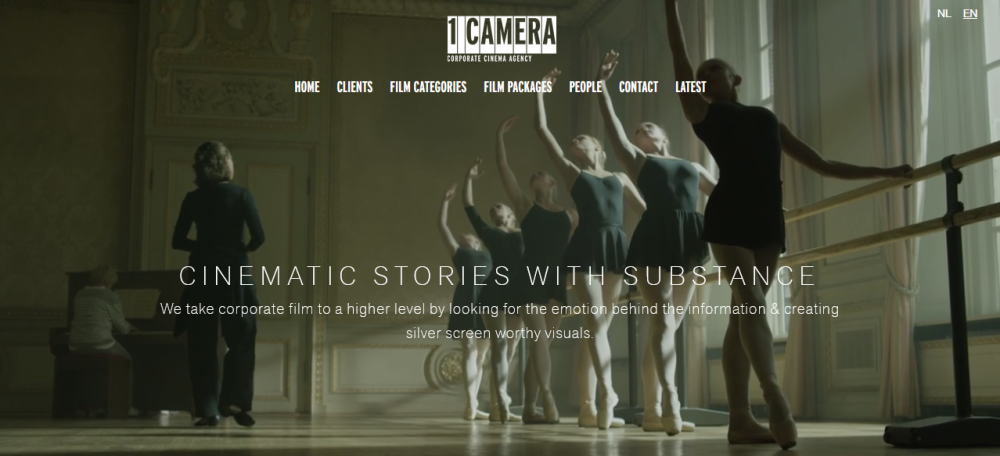
1. A Closer look at 1Camera
1.1 | From an Outsider Perspective – 1Camera at First Glance
‘Cinematic stories with substance’ is the first, full-caps tittle on the official website, a tittle which you will be sure to find verified after a brief scroll past the website and her content. The page starts with a cinematic showreel video filled with drone-shots, extreme close-ups and carefully lighted scenery on autoplay, displayed in a full-width container for a cinema-feel. Scrolling further you will find that film-festival laurels and star-ratings rule the website. Everything is bold and visual, even the crew photo looks like a classic hand-drawn movie poster.
1.2 | Looking further…
1Camera’s main platform of establishment is their company website. The company is also active on social media with an official account on vimeo, linkedin, instagram, facebook and twitter, however, these social links are only linked to at the very bottom of the website and absent in the main header, underlining the corporate approach of the Audio-Visual company.
It is interesting to note that the .nl website automatically loads in English, signifying an International-interest. When reading further you will note a kinder tone of voice, yet referring to credibility for their work by the awards won, academia notices and big-name clients. 1Camera offers 3 different type of productions: Lite – Classic and Cinema productions.
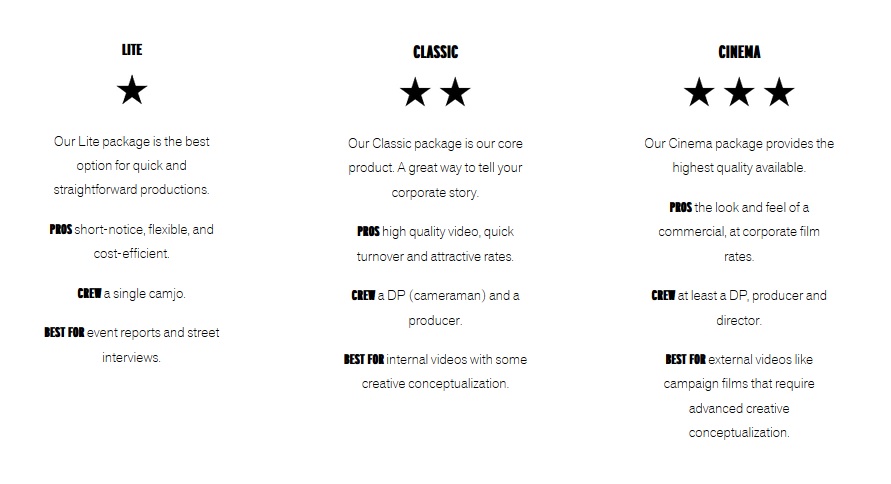
- A Lite production for straightforward, quick, small crew solutions.
- The classic package for high quality videos with some creative conceptualization and storytelling.
- The cinema option for the most advanced, creative films created by big crews with quality engagement.
Even though the classic production is described as ‘our core product’, most productions showcased in the online portfolio are of the type ‘Cinema’.
2. Mission, Vision & Positioning
2.1 | Considerations from an insider perspective
From an insider POV matters always feel a bit different, however, there is one main alteration I experienced during my first month at 1Camera which I would like to point out in particular. Which is the question of Mission, Vision & Positioning.
2.2 | High-end & Low-end.
On the 1Camera website all productions are advertised as cinema ready material, placing big remarks about the silver-screen worthy visuals. Their positioning focuses on high production value and overall large-scale-ness of matters. However, most 1Camera productions come together through small screws, flexible outings and last-minute soft scripts; the ‘lite’ productions. Even though 1Camera strives for big-budget ‘cinema’ productions, in reality most clients refer to 1Camera for their low-end ‘lite’ packages. When ‘cinema’ productions do occur, 1Camera hires an external crew (often including the Director and DP) to do the job, almost operating like line-producers.
On their website, 1Camera advocates for the Classic Production as their ‘most chosen product’. They want to produce Cinema Productions. In reality the clients choose for Lite Production products.
3. Searching for Solutions
This raises interesting questions about the dream-identity of the company and the actual every-day flow of matters. There is an aim for aesthetics – high-value – creative and global trades, but the everyday reality of 1Camera consists of mainly testimonials, corporate statements and nowadays; many Vlogs. Is it possible to fill this creative need for cinema-quality content even when working with low-end production, crew and equipment? Can we up the visual quality of our images and communicate in more creative means?
Can we create ‘cinematic stories with substance‘ by applying more extended and creative film making language even when operating in small non-fiction equipped crews?
3.1 | Approach & Ideas for improvement
In any format of film and especially corporate productions, the story is always to be considered first. Cinematic images alone do not communicate a message; for making film a profitable, corporate product a thought needs to be communicated which is done through storytelling.
1Camera is highly aware of the need of such a story. Choosing for small crews is often a conscious choice made not only for a financial cause but also to serve the story. For 1Camera a small crew means (next to a budget-saver) less distraction for the subject on film, allowing emotions to flow in a more natural sense and capturing these in a more raw format. Even I, as an intern, am not always allowed to participate on shooting days to keep the mood on set authentic and low-key.
Working in such a documentary-style format, with a soft script and moveable crew allows 1Camera to adapt, react and observe as flexible as possible. This brings 1Camera the Unique Selling Point of adaptability to unscripted, unique story elements, however, this also contributes to an end-product of a lesser visual quality: with shaky movement, unfocused areas and un-light situations. Making an adaptable story also means less space for creative conception and deep visual language due to more limited resources.
Such an end product does not correlate with the image 1Camera envisions. Unless shaky movement becomes a stylistic choice, and an un-light situation is paired with well light shots and becomes a story (turning) point.
4. Analysing Current Workflow
4.1 The Soft Script for Low-End Productions
At 1Camera, low-end productions often work with a so-called Soft Script. These scripts communicate an approximate framework of what is seen vs what is heard in the final video from beginning to end. These sheets are kept as reference for client communication during pre-production, as a shot-list and interview guide during production hours and as an editing reference during post. This provides an excellent base grid for all stages of production and preserves the freedom of a Non-Fiction production approach.
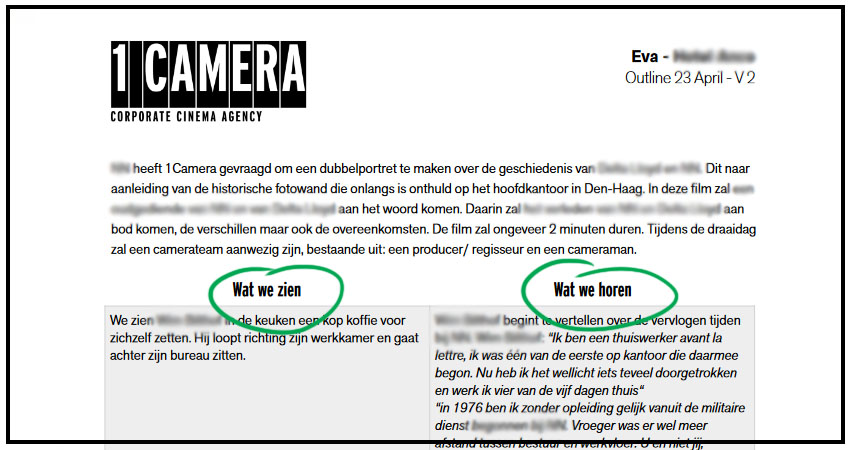
4.2 Go1 – Intranet
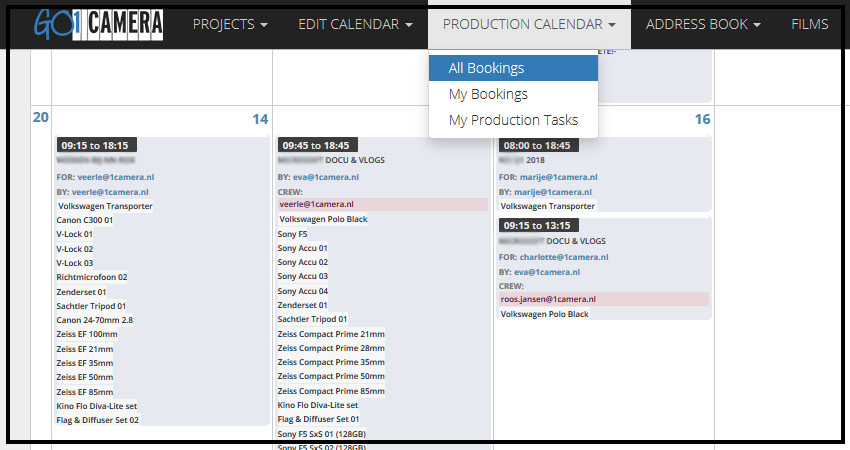
Next to the Soft Scripts, the (pre-)production workflow at Corporate Cinema Agency 1Camera takes place within a digital environment named ‘Go1’. This in-browser experience keeps track of:
- Projects
A live overview of projects categorized by status, company, producer, client, crew members involved and type of production (lite, classic, cinema). The overview also includes a quick-view window with an overview of the ongoing projects, their state of production and the producer involved.
- The Production Calender
An online environment in which Producers can book equipment and crew-members for upcoming productions. This calender-design environment is public to all 1Camera members so an overview is shared publicly of which equipment and crew members are booked for which production days.
- The Editing Calender
An online schedule which communicates which editors/animators/colour artists are booked. Bookings are scheduled by time-frame per day and include an editing suite as well as additional project information. The Editing Calender is available for all 1Camera members to see.
- Address Book
An address book with details of both 1Camera staff as well as freelancers divided by profession.
- Films
An online archive of all 1Camera productions since 2013. The archive includes a search tool for filtering available films by company, crew-member, producer, freelancer and year of production.
After a conversation with Managing Partner Paul Keur at 1Camera, I was informed about current ongoing developments for a 1Camera App. Details about this app are still vague, however, 1Camera has communicated huge interest in the development of a more integrated and on-the-go digital space.
5. | Opportunities
My first question after reading the Soft Script is always: “So how do you think we should capture these ‘What we see’ moments, in regard of visual style choices?” . Sometimes thoughts about these are motivated as the DP and Producer in question shared a talk and/or inspiration video(s) about the visual style. However, just as often the visual style of low-end productions is only considered briefly, through type of camera shot (LS, MS, CU) and movement (often a walking shot) alone.
Opportunity I
Opportunity would be to closer examine the visual language from the creation of the Soft Script and onwards, so that a clear visual style can be linked to the production giving the video an unique, focused and consistent look. An early implemented ‘how we see’ tab would give the DP on set a much more focused approach to the tasks at hand, knowing more exactly what to look for and having been able to conduct research to the chosen visual style and how to achieve this look.
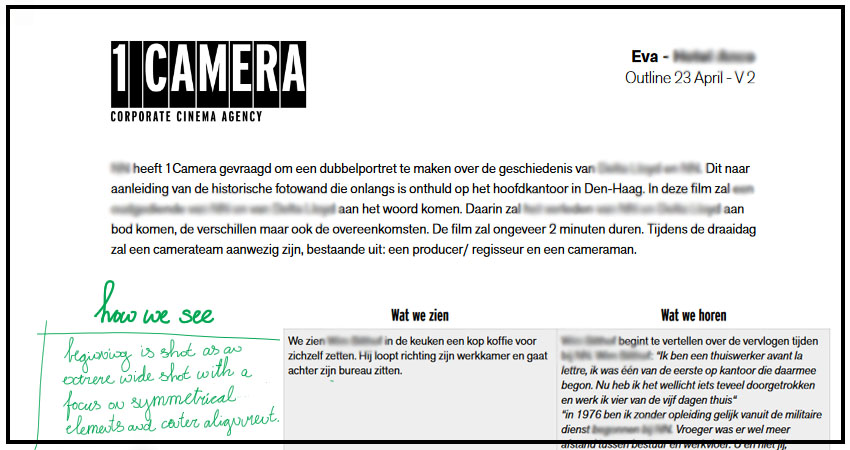
Example from Image: The ‘how we see’ scope now suggests that the story is portrayed through extremely wide angles with a focus on symmetrical elements and centre alignment, giving the DP an instant idea on how to capture the scene with more visual means instead of jumping in using the standard motives, allowing an unique and more intriguing look to unfold.
Opportunity II
Another opportunity would be to apply story structure to the ‘what we hear’ scope. As of now there are no additional remarks about dialogue belonging to the beginning – middle or end of the video. Although one can assume the first part belonging to the beginning and the final lines indicating the end of the video, there is no true indicator of where we shift from the beginning to the middle part and which lines are the gravitating turning points of the story.
Underlining such turning points would boost the story rhythm through ‘story drivers’; little peaks the story gravitates towards and demanding the audience to keep intrigued by what is next. Identifying those peak moments makes the story more engaging, helps the producer to keep the story dynamic, the DP to highlight turning points through visual means and the editor to work towards these drivers with tools such as sound and pacing.
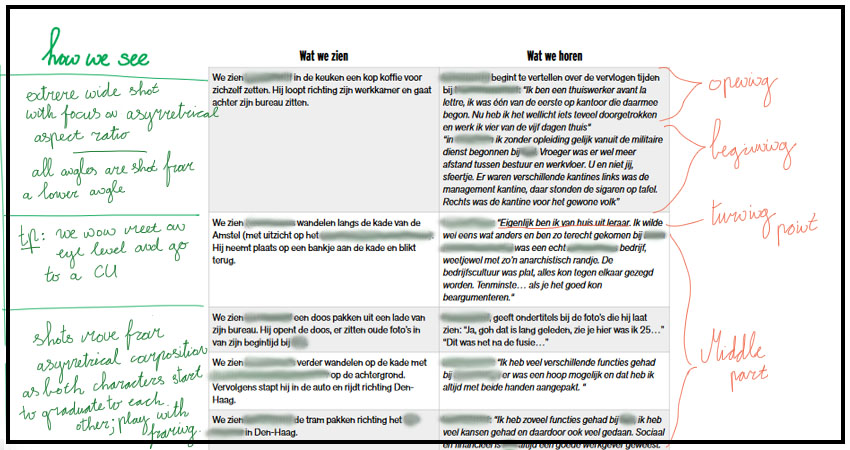
Example from Image: Note how the ‘how we see’ scope has changed as we have given the story more meaning through narrative structure. The story now flows from
- (Opening) Introduction to a high-born, prestigious figure who..
- (Turning point).. has quite relatable and ordinary dreams.
- In the middle part we then read about another similar figure and these are forced to work together, which brings with the necessary concerns.
- (Turning point) However, as they meet it turns out these concerns are far less of a problem than first assumed.
- (Ending) Their collaboration is the start of a complete new promising business.
The visual language from the ‘how we see’ scope now underlines this story by starting with:
- (Opening) Extremely wide shots filmed from a low angle. We avoid symmetry.
- (Turning point) We meet eye level and gravitate to a close up.
- In the middle part the alignment is all over the place, sometimes even annoyingly so.
- (Turning point) We find both characters in a perfectly balanced, symmetrical two shot.
- (Ending) Even their separate shots are now symmetrical, as balance has been restored by the introduction of their newly found collaboration partners and resolved presuppositions.
Chapter 1 | Summing-Up
Even though 1Camera brands their identity around cinema-ready productions, the high-end cinema-package which the company offers is far less applied than the low-end Classic & Lite packages. Even when Cinema productions are requested, an external production crew is hired. This means that the everyday reality of 1Camera employees exists of mostly low-end ‘lite production’ means. This raises questions about the dream-identity of 1Camera and its everyday reality; how to incorporate the ambitions of 1Camera when the paying client demands lesser resources?
Scripting the lite-productions too precisely would remove the USP of its adaptability to the story and lesser the motivation for such productions massively. As of currently, 1Camera approaches lite productions which is so-called ‘soft-script’ and through the help of the digital Go1 environment.
Go1 is created for internal communication about ongoing projects, calender activities, freelance contacts and to showcase finished productions for reflecting on.
The Soft Scripts communicate the crew a basic overview of what activities a shooting day will consist of and what is to be filmed during these activities, like a planning/shot list. Perhaps there is potential in elaborating on the Soft Script format. Deeper knowledge to the Non-Fiction production format could perhaps inspire low-end opportunities to turn weakness into strength.